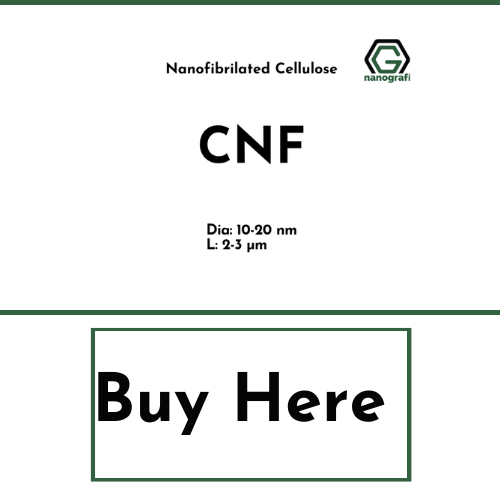Explained: Cellulose Nanofibers
Due to the pressures of a growing population and rapid growth in materials research, manufacturing demands have resulted in unsustainable use of petrochemical resources which in turn have contributed greatly to global pollution and climate change.
In today’s more eco-conscious society, environmentally friendly biopolymers present a sustainable alternative to fossil-based resources.
Introduction
In this regard, cellulose is the main component of lignocellulosic biomass and is the most abundant biopolymer on earth. Cellulose is a β (1-4)-linked chain of glucose molecules, accounting for around 50% of the carbon content in the lignocellulosic biomass. Therefore, this macromolecule, as a sustainable and renewable source, has garnered significant interest and encouraged researchers to develop cellulose-based materials with novel functions. Nanomaterials derived from cellulose are referred to as nanocellulose. Nanocellulose can be mainly categorized into nanocrystalline cellulose (NCC), nano-fibrillated cellulose (NFC), and bacterial nanocellulose (BNC). These types of nanocellulose, although very similar in composition, could present some differences in morphology, particle size or crystallinity, due to the different sources and extraction methods.
Cellulose
Cellulose is the most abundant raw material on earth. About billion tons of cellulose is being produced from various plants every year. Cellulose is renewable, biodegradable, cheap, thermally stable, light in weight and have many other good properties. Plant cellulose fibers are made of highly crystalline microfibrils, so-called cellulose nanofiber (CNF), which have unique properties and sizes. Recently, cellulose has received huge attention because of its broad impact in many areas such as pharmaceuticals, coatings, food, textiles, laminates, sensors, actuators, flexible electronics and flexible displays. CNF has typical width around 5~20nm and a length of several micrometers. CNF can be isolated by homogenization, grinding, micro-fluidization, acid hydrolysis, and oxidation. CNF is not soluble in water but highly dispersible which makes it possible to make a suspension with a certain viscosity. This indicate that it is possible to spin CNF suspension. CNF has anisotropic physical properties. The elastic modulus of highly crystalline CNF was reported about 150GPa in the longitudinal and about 18–50GPa in the transverse direction.
ellulose was first discovered in 1838 and is the principle constituent of plant cell walls. Structurally, cellulose is a carbohydrate with similar chemical composition to starch (C6 H10 O5)n. Although the chemical composition is similar, and both are formed by glucose as a monomer with (1,4) glyosidic bonds, there is a difference in the type of bond, since the cellulose monomers are β-1,4 bonds, and the starch bonds are α-1,4. However, unlike starch, cellulose is insoluble in water solvents. Starch (formed by amylose and amylopectin) dissolves in water because of the α-1,4 glycosidic causes the formation of a helical structure that does not form inter-strand hydrogen bonds, producing easily-disruptable non-polar interactions between glucopyranose rings. In the case of the cellulose, this presents a structure that is tightly bound in a set of hydrogen bonds between individual chains, resulting in an inter-strand hydrogen bond that can easily expand and flex to allow the penetration of water, which together with its higher degree of polymerization, mean that it is insoluble.
Cellulose Nanofiber
Cellulose nanofiber is made from wood-derived fiber (pulp) that has been defibrated to the nano level of several hundredths of a micron and smaller, cellulose nanofiber is the world's most advanced biomass material. As the material is derived from plant fibers, it creates low environmental impact in its production and disposal. Among its outstanding characteristics, it is lightweight, has an elastic modulus as high as that of high-strength aramid fiber, exhibits thermal expansion on par with glass, and presents high barrier properties with regard to oxygen and other gases.
Cellulose nanofibers (CNF), also known as nano-fibrillated cellulose, are a type of flexible, elongated, cross-linked nanocellulose that can be extracted from cellulose fibers by mechanical treatment. In order to obtain cellulose nanofibers, it is necessary to subject the raw material to a purification process similar to that which is carried out to obtain CNC. NFC is generally produced by mechanical delamination of cellulose fibers after a previous treatment (pre-treatment) that facilitates disintegration. These pre-treatments avoid the occlusion of the equipment where the disintegration process takes place, and reduces the number of passes or treatment time, with the reduction of energy that this entails. CNF was first isolated in 1983 by Turbak et al. [7] using bleached softwood fiber and subjected to a high-pressure homogenization process. However, the high energy consumption necessary for its production limited the scientific and industrial interest. In order to reduce energy consumption and make disintegration more efficient, different pretreatments, such as enzymatic hydrolysis, partial carboxymethylation, catalytic oxidation using 2,2,6,6-tetramethylpiperidine-1-oxyl (TEMPO), and mechanical refining were employed. After pre-treatment, the fiber is subjected to a mechanical disintegration process, including high pressure, micro-fluidization, friction grinding, extrusion, cryopressure and high intensity ultrasonication.
Although CNF has superior mechanical properties, it is too short to be used for fibers of strong and environmentally friendly composites, for example, CNF fiber reinforced composites. Thus, fabrication of a cellulose long fiber with CNF is challenging without sacrificing high mechanical properties of CNF. Generally, alignment of the nanofibers can improve the mechanical properties. Many attempts were already reported to align CNF such as magnetic field, electric field, shear force and mechanical stretching. CNF orientation using shear force is very simple and have a potential for large scale production. Spinning is a promising and efficient way to get uniaxial oriented CNFs. Besides spinning, mechanical stretching can also improve the CNF orientation resulting in high mechanical properties.
To get more information about utilization of carboxymethyl cellulose micron powder,
you can read our blog post here.
Applications of Cellulose Nanofiber
Due to its morphology and characteristic physical properties, cellulose nanofiber is seen as a promising material for use in a wealth of fields, including filter material, high gas barrier packaging material, electronic devices, foods, medicine, cosmetics, and health care.
Potential Applications
The properties of nanocellulose (e.g. mechanical properties, film-forming properties, viscosity etc.) makes it an interesting material for many applications.
Paper and Paperboard
In the area of paper and paperboard manufacture, nanocelluloses are expected to enhance the fiber-fiber bond strength and, hence, have a strong reinforcement effect on paper materials. Nanocellulose may be useful as a barrier in grease-proof type of papers and as a wet-end additive to enhance retention, dry and wet strength in commodity type of paper and board products. It has been shown that applying CNF as a coating material on the surface of paper and paperboard improves the barrier properties, especially air resistance, and grease/oil resistance. It also enhances the structure properties of paperboards (smoother surface). Nanocellulose can be used to prepare flexible and optically transparent paper. Such paper is an attractive substrate for electronic devices because it is recyclable, compatible with biological objects, and easily biodegrades.
Composite
As described above the properties of the nanocellulose makes an interesting material for reinforcing plastics. Nanocellulose can be spun into filaments that are stronger and stiffer than spider silk. Nanocellulose has been reported to improve the mechanical properties of thermosetting resins, starch-based matrixes, rubber latex. Hybrid cellulose nanofibrils-clay minerals composites present interesting mechanical, gas barrier and fire retardancy properties. The composite applications may be for use as coatings and films, paints, foams, packaging.
Food
Nanocellulose can be used as a low-calorie replacement for carbohydrate additives used as thickeners, flavor carriers, and suspension stabilizers in a wide variety of food products. It is useful for producing fillings, crushes, chips, wafers, soups, gravies, puddings etc. The food applications arise from the rheological behavior of the nanocellulose gel.
Medical, Cosmetic and Pharmaceutical
The use of nanocellulose in cosmetics and pharmaceuticals has been suggested:
- Freeze-dried nanocellulose aerogels used in sanitary napkins, tampons, diapers or as wound dressing
- The use of nanocellulose as a composite coating agent in cosmetics e.g. for hair, eyelashes, eyebrows or nails
- A dry solid nanocellulose composition in the form of tablets for treating intestinal disorders
- Nanocellulose films for screening of biological compounds and nucleic acids encoding a biological compound
- Filter medium partly based on nanocellulose for leukocyte free blood transfusion
- A buccodental formulation, comprising nanocellulose and a polyhydroxylated organic compound
- Powdered nanocellulose has also been suggested as an excipient in pharmaceutical compositions
- Nanocellulose in compositions of a photoreactive noxious substance purging agent
Other Potential Applications
- As a highly scattering material for ultra-white coatings.
- Activate the dissolution of cellulose in different solvents
- Regenerated cellulose products, such as fibers films, cellulose derivatives
- Organometallic modified nanocellulose in battery separators
- Reinforcement of conductive materials
Conclusion
There has been an explosion of interest in the use of biomass as a source of renewable energy and materials. Despite being the most available natural polymer on earth, it is only quite recently that cellulose has gained prominence as a nanostructured material, in the form of nanocellulose. This term covers the range of materials derived from cellulose with at least one dimension in the nanometer range. It mainly consists of chemically (cellulose nanofibers–CNFs) or mechanically extracted nanoparticles (micro-fibrillated cellulose – MFC). After intensive research, several initiatives have emerged in the perspective of producing nanocellulose on a large scale. Nanocellulose-based materials are carbon-neutral, sustainable, recyclable and non-toxic. They thus have the potential to be truly green nanomaterials, with many useful and unexpected properties.
To get more information, you can visit Blografi.
References
1.A. Dufresne, Nanocellulose: a new ageless bionanomaterial, Mater. Today 16 (2013) 220–227.
2.A. Dufresne, Nanocellulose: potential reinforcement in composites, Nat. Polym., Vol. 2: Nanocompos. 2 (2012) 1–32.
3.H.V. Lee, S.B.A. Hamid, S.K. Zain, Conversion of lignocellulosic biomass to nanocellulose: structure and chemical process, Sci. World J. 2014 (2014) 1–20.
4.Giri, J., & Adhikari, R. (2012). A Brief review on extraction of nanocellulose and its application. Bibechana, 9, 81-87. doi:10.3126/bibechana.v9i0.7179
5.Börjesson, M., & Westman, G. (2015). Crystalline Nanocellulose — Preparation, Modification, and Properties. Cellulose - Fundamental Aspects and Current Trends. doi:10.5772/61899
6.Klemm D, Heublein B, Fink HP, Bohn A. Cellulose: fascinating biopolymer and sustainable raw material. Angew Chem Int Ed. 2005;44:3358–3393.
7.Habibi Y, Lucia LA, Rojas OJ. Cellulose nanocrystals: chemistry, self-assembly, and applications. Chem Rev. 2010;110:3479–3500.
8.Sjostrom E. Wood Chemistry: Fundamentals and Applications. 2nd ed. California: Academic Press Inc; 1993.
9.Moohan, J., Stewart, S. A., Espinosa, E., Rosal, A., Rodríguez, A., Larrañeta, E., Domínguez-Robles, J. (2019). Cellulose Nanofibers and Other Biopolymers for Biomedical Applications. A Review. Applied Sciences, 10(1), 65. doi:10.3390/app10010065
Recent Posts
-
Turning Noise into Power: Energy Harvesting with Piezoelectric Nanogenerators
Ambient acoustic energy, once an untapped resource, is now being converted into sustainable electric …5th Mar 2025 -
Holey Super Graphene in Li-ion Batteries: Next Generation of Energy Storage
Holey Super Graphene (hG), also referred to as “holey graphene,” is redefining li-ion ba …7th Feb 2025 -
Future Communication with 5G Technology and Advanced Materials
5G technology opens the doors to a new era in communication with faster connection speeds, low laten …6th Feb 2025







